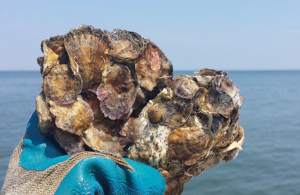The oyster season in the Chesapeake Bay recently ended, but this year oysters harvested in the Rappahannock River came from an unusual home. Some of the oysters they harvested were grown on gravel-sized stones that had been put in the river to provide an unconventional growing spot. Usually, baby oysters, or spat, are grown on old oyster shells, and watermen have long thought that this was the best way to grow the highest numbers of oysters. But research from the Virginia Institute of Marine Science and the University of Maryland is contradicting this old claim.
The Bay Journal recently featured a story of how alternative materials are being used to grow oysters in a time when oyster shells are in low supply, despite an old belief that oysters could only be grown at high numbers on shell. Watermen, especially in Maryland, believe that it is essential to grow oysters on old shells, and the Maryland Department of Natural Resources responded to their concerns and blocked the use of non-shell materials to build reefs in the Tred Avalon. They complained that the rocks would interfere with crabbing and fishing, and that large debris was too hard to pick up with the hand-tongs they used to harvest some oysters. Conservationists were concerned that oil and other contaminants on old roads and old building materials would pollute local water if used to build reefs.
Back in 2011, the University of Maryland teamed up with the US Army Corps of Engineers to test some of these concerns. The team built reefs out of granite in the Choptank River and loaded with spat. Then the team planted the reefs at the University of Maryland Center for Environmental Science Horn Point hatchery. The researchers found, after three years, that there were more oysters on the reefs made of granite and shells, but that the ones made out of granite alone had healthy population densities. They also found that using smaller stones, small enough to be handled by tongs, also worked for oyster populations. Larger pieces of debris could still be used in sanctuaries, and in harvested reefs, a mix of smaller debris and shells will work well.

Oysters attached to granite.
Rom Lipcius, a researcher at the Virginia Institute of Marine Science who studies oyster conservation, told The Bay Journal that alternate materials performed equally well with shell. He added that larger chunks of concrete or granite have the added benefit of being less likely to be covered in sediment, making it easier for spat to find the large pieces and latch on.
A recent study at Morgan State University found that old pavement from the Maryland State Highway Administration did not pose a contaminant risk to the water. They tested for chemicals that might leach into the water, and found that there was less pollution than in drinking water.
Tommy Kellum, the president of W.E. Kellum Seafood, recently worked with the Virginia Marine Resources Commission to test using crushed concrete and stones from a demolished bridge. This season they harvested oysters from two-year-old granite and had great results. He reported that the spat attached easily and that they grew well. In a time when finding oyster shells is proving difficult, recycling building materials might be the best way to keep oyster populations high.
